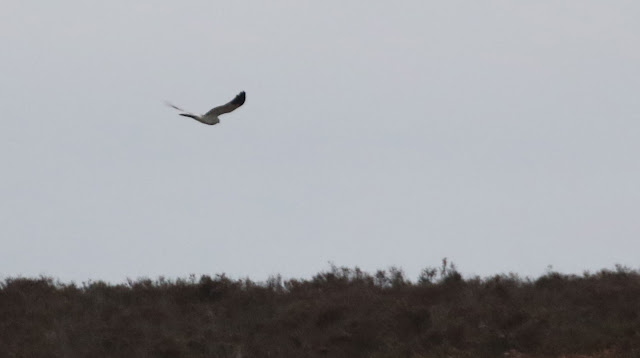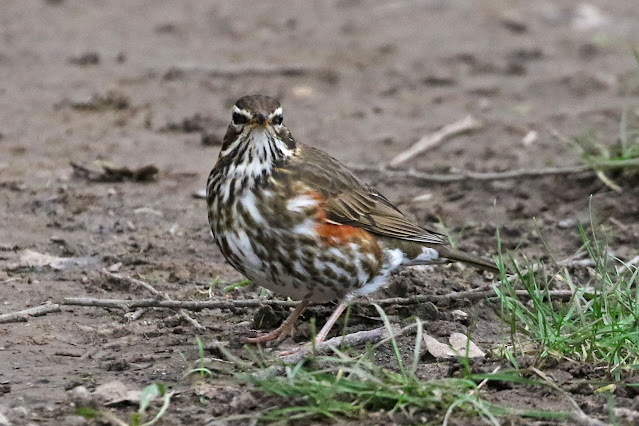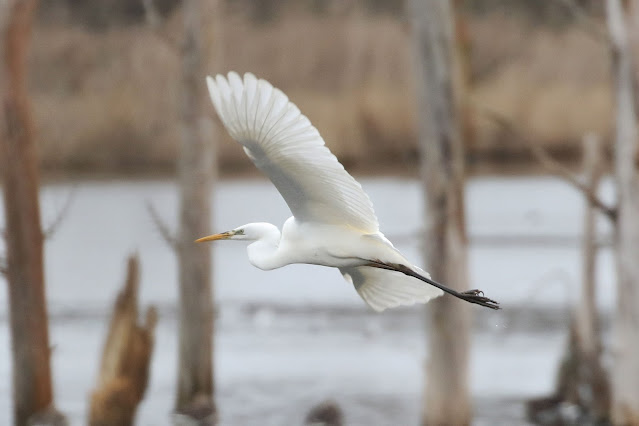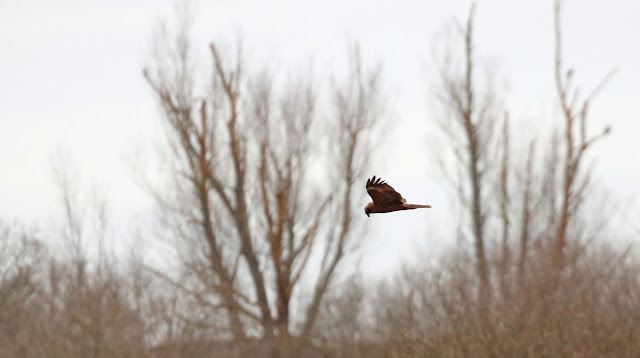I had a plan and the plan involved an early start. I pulled off the Roger Penny Way at the layby at the path to Black Gutter Bottom around 6:45am, it was pitch black and as I walked down the hill towards the stream I needed a torch to find my way. Bizarrely I could see a torch light on the other side of the valley coming towards me. As I reached the stream it crossed and headed towards the road. I think it was a dog walker, but they had walked through the bracken and had not taken the path. I made my way uphill to a clump of gorse and settled in to wait.
I was here to try and get a better view of the male Hen Harrier I had seen on Christmas Eve, then as it left the roost it headed west along the ridge, I had positioned myself in the place where it passed through last time. Sun rise was due to be 7:40am, but it was an overcast morning, still and a little cold. In the darkness I could hear calls that didn't make sense, they sounded duck like and I eventually sourced them to the stream and pools and I think they were either frogs or toads. It was dark, something not seen in these photographs looking north down hill, then south up hill.
The first bird song heard was that of a Song Thrush, followed by the alarm calls of a Blackbird and then the calls of a Chaffinch which even managed a snippet of song. at about 7:30am from behind me I heard the "gronking" call of a Raven and saw four pass over heading south. I then saw another five in the same direction and a few minutes later three passed overhead this time heading north and calling.
The time for sun rise came and went without any sign of the harrier, Meadow Pipits were calling and Carrion Crows flew along the valley bottom. The light was becoming more passable and there was a hint of colour in the clouds that was encouraging. Just after 8:00am I started to question myself, had it headed off in the other direction? This nagging thought drove me to walk down the hill towards the valley bottom where I would get a view in both directions. There was nothing.
I crossed the stream, it was now 8:15am, 35 minutes after sun rise. From behind me I heard a Crow call, I don't no why I turned but I did and there crossing the open area, having passed over where I had been standing was the male Hen Harrier.
Once again my lack of patience and belief had let me down and I was left to watch a distant (although not as distant as Christmas Eve) male Hen Harrier glide across the valley towards the ridge once more.
It then dropped below the sky line, heading over the gorse and heather while being chased by a Crow.
Unfortunately grainy photographs, but the best I have had for some time.
I followed it with the binoculars and could see it had been joined by a small falcon, clearly a Merlin, they are known to roost together and maybe the small falcon benefits from the Hen Harrier disturbing small birds, but I couldn't find any reference to information on tagging along with Hen Harriers, but there was a reference to this behaviour in North America with Sharp-shinned Hawks.
Both drifted out of sight and I was left with a moment of joy and then one of what might have been. Do I come back for a third attempt?
I walked back up the slope and headed through the small copse of pine trees. Here I disturbed a Fieldfare on the ground and it flew off with a noisy call. Back at the car I decided to head to the south and Shatterford to try and find that other wintering grey bird, the Great Grey Shrike.
Again on Christmas Eve I had found the shrike with Ian, but on the Pig Bush side, over the last few days it had been reported from the other side of the railway along the line of birch trees that run along the stream towards Denny Wood.
From the car park I headed along the track that runs parallel with the railway line. on reaching the slope that leads to the railway footbridge I met a birder who had just seen a ring-tail harrier, but not the shrike. I scanned the area looking for that tell tale white blob at the top of a tree or bush. There was nothing so I walked on towards the foot bridges over the streams. Nothing here, I continued into the woods to cross over to Rowbarrow pond, the site we had seen it on Christmas Eve.
Song Thrush sang from the trees as I walked through the copse towards the footbridge.
Having crossed the railway I could hear a Stock Dove calling and found it at the top of a dead Silver Birch tree
Coming out of the trees I could see a distant Buzzard, but no sign of the shrike.
I turned around and headed back, stopping for a Mistle Thrush that was at the top of one of the beech trees.
Perhaps an over looked bird.
Back on the other side of the track I came across Blue and Great Tits feeding in the leaf litter, there was also a pair of very vocal Nuthatch.
I walked across the bog towards the foot bridges and scanned the line of birches, once again nothing. I made my way back to the footbridge across the railway line and crossed to scan the Pig Bush area, again nothing. Coming back I stopped to talk to another birder who had also drawn a blank. We both thoroughly scanned the area, but again nothing. Having had great views on Christmas Eve and some good photographs I wasn't too concerned and satisfied my self that a distant white blob would be sufficient for the year tick, but I still couldn't find the white blob.
Eventually I decided it was time to call it and walk back to the car. I made it about halfway back to the car park, when for some reason I decided to look at my phone and there it was, Great Grey Shrike at Shatterford, seen about 10 minutes ago. Fortunately there was a location reference and a quick check revealled I must have walked past it, although it would have been distant.
What to do? I decided to turn back and route marched my way along the path. On reaching the ridge I could see a few birders with scopes up, one of which was the guy I had been talking through. I assumed that they must have been those who had reported it. I walked on, but when I reached them, they hadn't seen it. We scanned with perhaps a bit more purpose and eventually the birder I had been with found it at the top of a dead pine, and yes it was distant and yes it was a greyish white blob.
Fortunately the view through the scope confirmed it was the shrike and I was happy with the year tick. I did wait to see if it would dare to come closer, but instead it moved to the right and disappeared behind more birches. I decided that this was now enough and route marched my way back to the car park, as I changed my boots I could hear Redwing above me, but couldn't see them.
The next stop was to be in Mercer Wat, Romsey, but I parked in the Fishlake Meadows and then walked along the Canal Path to the playing field area that has been home to a pair of Hawfinches over the last week. This was always
THE Hawfinch site in the county, but since the large influx in the
winter of 2017/8 there have been few reports. That year there were several birds in the area nd were quire easy to see both in the trees and on the ground.
As I crossed the canal and walked on to the playing field I could see Redwing and Song Thrushes feeding on the grass. The Redwing flew off, but one Song Thrush showed very well.
There were several birds in the surrounding trees and the first one I checked was a Redwing, but the second was a very smart male Hawfinch.
I have not been this close to a Hawfinch for sometime, recent sightings being distant tree top sightings in the New Forest. The first thing that struck me was the size of the bill.
Then something spooked it and it flew back into the taller trees, but It was now a little more accessible without branches in the way, but a little higher up so I was looking up at it.
The hawfinch is a huge finch, weighing over twice as much as
the more familiar Chaffinch. It uses its powerful bill to crack open seeds from
trees such as cherry, hornbeam and beech, but in summer often feeds on insects
as well. The bill of a hawfinch can
exert a pressure of over 150 pounds per square inch. That's enough to crush
even an olive stone, and the equivalent of a thousand times its own weight.


It is a robust bird with a thick neck, large round head and
a wide, strong conical beak with a metallic appearance. It has short pinkish
legs with a light hue and it has a short tail. It has brown eyes. The plumage
of the female is slightly paler than that of the male. The overall colour is
light brown, its head having an orange hue to it. Its eyes have a black circle
around them, extending to its beak and surrounding it at its edge. Its throat
is also black. The sides of its neck, as well as the back of its neck, are grey.
The upper side of its wings are a deep black colour. The wings also have three
stripes from approximately the middle till their sides: a white, a brown and a
blue stripe
It sat motionless other than the head looking around at any possible above and in the trees.
Again the bill was striking
Hawfinches are found in large areas of mature broadleaved
woodland, favouring areas with open glades. Shy birds, they can be extremely
difficult to find in summer, remaining high in the canopy and rarely calling.
In winter, numbers are boosted by continental migrants, and birds are easier to
spot in leafless trees.
Then a squirrel disturbed and it flew to a position much higher in the tree and behind a lot of branches. It sat there for awhile but then flew to the back of the small group of trees and I lost it. Always wanting the best photograph I hung around and walked around trying to be able to locate it. This involved also a lot of time standing still and watching.
Chaffinches could be seen in the trees and also feeding in the leaf litter below the trees and there were several Blackbirds. Redwing could be heard overhead and one appeared alongside me giving some great views.
Securing a quite substantial worm
Head one the streaks down the neck, breast and belly serve to camouflage the bird in the trees and it also does seem to affect the focus capabilities of the camera. But it does make them a very striking bird with the eye stripe as well.
I was distracted by a pair of Long-tailed Tits in the branches above
Back to the Redwing which was now closer on the mud below me.
Named after its rouge underwings, the redwing is the
smallest thrush in the UK. A social nomad, this berry-loving bird only visits
over the winter months, with just a handful of breeding pairs staying here all
year round.
Redwings are currently colonising Britain with about 50-100
pairs breeding in the highlands of Scotland. They require scrubby areas.
However, it is during the winter that they really feature as part of our bird
life.
Redwings,
wintering on the UK mainland may breed as far east as 160 degrees of longitude.
Intriguingly, many birds ringed in Britain, Ireland and other western European
countries during winter have been recovered in subsequent winters in
trans-Caspian countries such as Georgia and Iran.
Redwings are quite variable, but there is a population which
is consistently bigger and more strongly marked than average. There are the
birds of the race coburni which breeds on the Faroes and
(mainly) in Iceland. They are up to 5% longer than the nominate birds. These birds are most likely to be found in
the west of Britain and Ireland where they winter.
It was nice to get the chance to be able to be close, both Redwing and Fieldfare, our other winter thrush, are notoriously shy birds and will fly at the slightest approach. This individual was extremely approachable and confiding.
There were several in the surrounding trees and I even came across one that was singing, quietly some form of sub-song. As is the way in places such as this, the other being the disused car park in Gosport, there were always bird surprises, a male Bullfinch appeared, another finch with a sizeable bill, but no where near the Hawfinch. The crimson red breast standing out amongst the drab grey and brown branches.
The Hawfinch didn't make a come back for me and I decided to walk back into Fishlake Meadows the reserve. I walked back down the canal path with Robins and Collared Doves the most active, the doves coming down to drink in the canal.
I went to the view point off the main road. The water level was high and there were quite a few duck on the water including Wigeon, Tufted Duck, Pintail and a few Pochard. A second view point has been created and from here I disturbed a Great Egret.
It flew out over the water and then circled around coming back to land on an old log aside the reeds.
Strangely this was the only heron or egret I saw all day.
I headed back down to the Canal Path and just past the bridge there was a a calling Chiffchaff and a couple of Wren that were engaging in a singing competition.
The canal path was very quiet, a few Long-tailed Tits and Blue and Great Tits about, while I could hear Chiffchaff but never managed to see them. I passed through the gate to walk through the reserve to the centre path and around the flooded ditch I disturbed a Grey Wagtail that flew around and fortunately returned to perch on the barbed wire fence.
The Grey Wagtail is one of those birds that is common but always special to see, probably due to their habitat in wetlands a streams.
I walked to the central screens but as usual there was very little of interest in front of them. The highlight had to be a group of four Snipe on an island and a Marsh Harrier that seemed to be doing a circuit of the reed beds in a clockwise direction.
Heading back I came across the Grey Wagtail once more
Once much more restricted to the fast-flowing rivers of the uplands, the grey wagtail has been able to expand its range due to improving water quality in many of our rivers in recent decades. It can now be found nesting in most parts of the country.
While watching the Marsh Harrier from the screens as it flew along what looked like the canal path I remarked how it never does that as you walk the path. But as I reached the first viewing platform on the way back the same bird glided past me.
Then it circled back and came past, now heading anti clockwise.
From the size it was probably a female bird, although there are fringes to scapulars which can indicate an immature, maybe second calendar year.
It drifted away and out of view.
I decided to stand and wait as its behaviour had been to circle clock wise. As I waited I was drawn to two birds overhead by the call, they settled distantly at the top of an alder and with this shot was able to get enough to claim them as Redpoll, the first for awhile.
The harrier wasn't returning so I walked on. Just before the bridge to the car park I stopped for a Chiffchaff catching insects in the bushes above the water. It showed very well.
There is something special about a Chiffchaff in the winter, probably the fact they are always seen as a summer migrant and the bringer of spring.
Wintering Chiffchaffs seem to be restless and always on the
move, often calling as they go, which helps in detecting their presence. They
need to be ever-active to find their insect food, no mean feat in a British
winter, adding 10-15% to their body-weight during the day and burning up that
fat during the long nights
A small proportion of the birds of the nominate race are
likely to be British breeders but the majority have probably migrated here from
southern Scandinavia or continental Europe.
And that was it for the day, a day of some quality birds if not the perfect photography conditions. Should be back with my wing man next weekend.






































































No comments:
Post a Comment